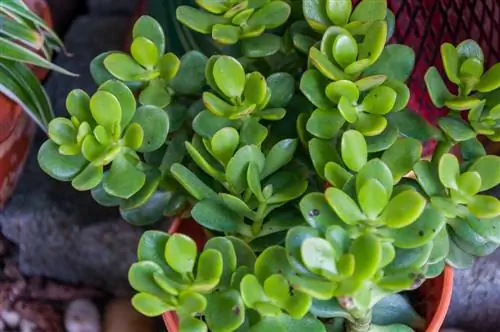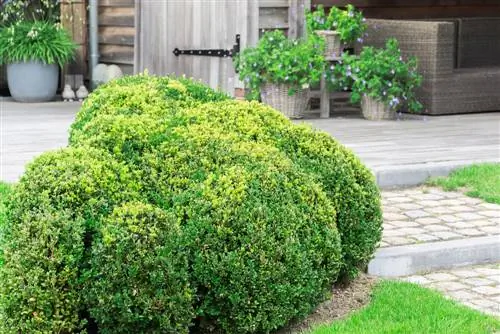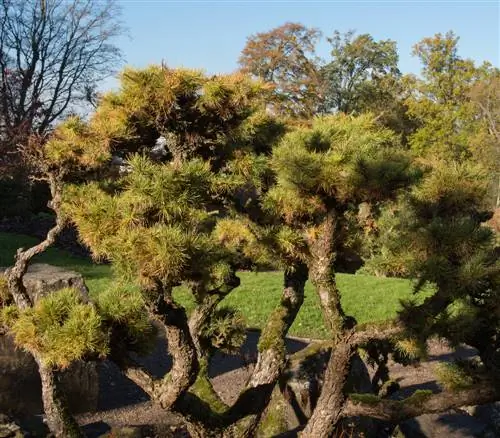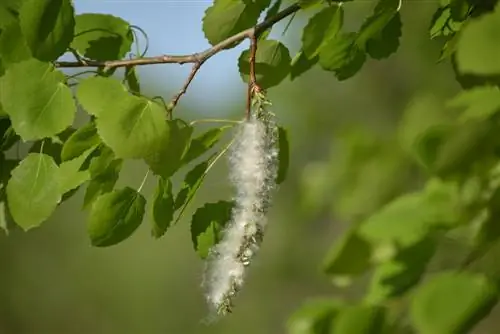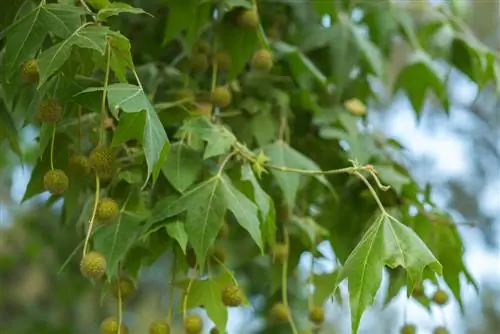- Author admin [email protected].
- Public 2023-12-16 16:46.
- Last modified 2025-06-01 06:02.
Succulents are not limited to a single plant family or genus. In fact, numerous plant species around the globe have the ability to store water and survive in regions hostile to life. Thanks to their undemanding nature, the survival artists are team-oriented companions for indoor gardeners who do not constantly insist on nurturing attention. Here you can get to know representative species that cause a sensation when displayed on the windowsill.

Which succulent species are particularly representative?
Among the representative succulent species are cacti such as gold ball cactus, royal agave, carrion flower, thick-leaved plants such as penny tree and flaming cat, spurge plants such as candelabra spurge and poinsettia, as well as hanging senile herbs such as peas on a string.
Cacti - bizarre primal figures with a dress of thorns
Cacti are the best-known representatives of succulent plants. Within this multi-faceted family there are tiny creatures ranging in size from just a few centimeters to giants that stretch 10 meters or higher towards the sky. The following species are at the top of the ranking of the most popular houseplants because they present themselves with a furious combination of bizarre shapes, beautiful flowers and colorful thorns:
- Gold ball cactus (Echinocactus grusonii) with golden yellow thorns and bright yellow flowers
- Greisenhaupt (Cephalocereus senilis) with white, hairy, columnar body and pink funnel-shaped flowers
- Christmas cactus (Schlumberga), leaf cactus without thorns and with a breathtaking abundance of flowers at Christmas time
The magical 'Queen of the Night' (Selenicereus grandiflorus) cannot be missing from this selection. At night, salmon-colored flowers up to 30 cm in size unfold on their slender, climbing tendrils, exuding a seductive scent.
King Agave - royal beauty for the windowsill
Representing the fascinating agave family, we would like to introduce you to the royal agave (Agave victoriae-reginae). It forms a dense rosette with its dark green sword leaves edged in white. In contrast to other agaves, the leaf edges are smooth. Only at the tips are there 2 cm long end spines. With a maximum height of 50 cm, the royal agave is considered one of the most beautiful succulent houseplants.
Carrion flower - flowers with a distinctive scent
A superlative succulent comes from the milkweed family. The large-flowered carrion flower (Stapelia gigantea) boasts 40 cm large flowers whose appeal no one can resist. Its light yellow base color has numerous red horizontal stripes. The petals are also covered in purple hairs. Since the exotic Pretiose reaches a height of 30 to 50 cm, it is actually a prime example of representative species - if it weren't for the unpleasant smell of carrion.
Thickleaf plants - floral jewelry for your home
The thick-leaf family has a variety of representative species to offer for home greening. To make your choice easier, we have put together the most beautiful examples for you:
- Pennig tree (Crassula ovata), shrub-like ornamental tree with thick, shiny green, oval decorative leaves
- Gold stonecrop (Sedum floriferum), delicate ground cover for bowls and troughs with golden yellow flowers
- Aeonium arboreum boasts dark wine-red leaf rosettes and yellowish-white flowers
A classic among the most beautiful thick-leaved plants for the home is Flaming Cat (Kalanchoe blossfeldiana). The succulent ornamental plant from Madagascar has everything we want from a representative houseplant. With a growth height of 30 cm and long-lasting spring blooms, the succulent is equally suitable for flower pots and hanging baskets. The plant stores water reserves in its thick-fleshed leaves so that it doesn't run out if the gardener misses watering from time to time.
Spurge - wild charm with succulent character
Because it has numerous representative species, the entire spurge genus was named perennial of the year in 2013. As the following selection proves, all Euphorbia deserve the title of succulent beauty queen.
- Candelabra spurge (Euphorbia abyssinica), majestic giant with angular shoots that can reach to the ceiling
- Baseball spurge (Euphorbia obesa) attracts everyone's attention with its spherical body
- Christmas thorn (Euphorbia milii var. milii), poisonous and thorny, but with beautiful flowers in the middle of winter
- Tirucalli spurge (Euphorbia tirucalli), richly branched shrub whose pencil-thin shoots are reminiscent of tuning forks
The spurge family has several representative species for the Christmas season. In addition to the thorny Christ thorn, the poinsettia (Euphorbia pulcherrima) has conquered a regular place on the winter flower bench. In the bright location with a pleasant 20 degrees Celsius, the flowering period extends from November to February.
Old herbs give us succulent hanging plants
Representative species among succulents are not limited to appearing along window and flower sills. The following species from the old-growth family are predestined for the spectacular decoration of traffic lights and hanging baskets:
- Peas on a ribbon (Senecio rowleyanus) with spherical, green leaves along thin, up to 100 cm long shoots
- Hanging ragwort (Senecio herreianus) impresses with gray-green, red-striped, thick leaves on 70 cm long tendrils
By the way, the succulents have well-known, non-succulent conspecifics among the old age herbs. The spring ragwort, for example, is well known to us from the natural garden and is feared by farmers because it is poisonous to grazing livestock.
Tip
Numerous representative species cannot be recognized as succulents at first glance. This includes the popular lucky feather (Zamioculcas zamiifolia), which should not be missing on any windowsill. With its dark green pinnate leaves on tightly upright shoots, the African beauty gives green liveliness even to niches with little light. Home gardeners who are short on time are lucky to have this easy-care succulent as their own.

